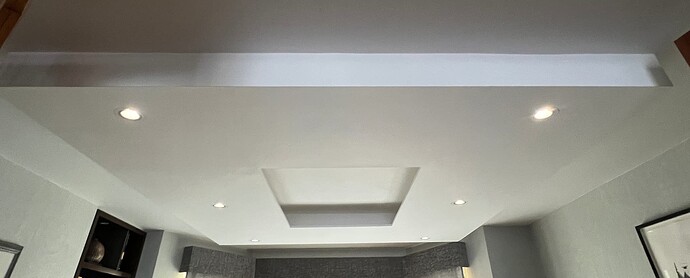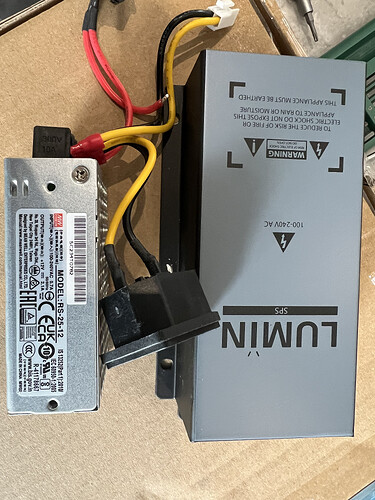I predict that Mytek products will improve and will win acclaim for features, design, and excellence in audio engineering. From challenges, opportunity.
It’s astonishing to me that this discussion is categorized under “Off Topic”. What topic, dear @moderators, is this off? I mean, if you know? Why isn’t it under “Audio Gear Talk”?
I cannot mention group @moderators? Really?
Personally I think this BB2 is a fantastic piece of engineering. The measured noise is inaudible. Issues with hum were discussed by Stereophile in their review and resolved because they liaised with the manufacturer.
I can’t agree more. I started streaming in 2010, became aware of Roon around 2015/16, but did not sign up until February 2019 because I’m not very good with tech and I found the server/core thing problematic. Roon is an incomparable product and this BB2 with an internal Roon Server would have been a godsend for me.
I doubt that there is an integrated Roon-centric product on the market that offers consumers such a complete feature-set and performance at the pricepoint, or any other price point. I doff my cap to @Michal_Jurewicz1.
Snide little comments that this is not audio excellence, if indeed there is nothing comparable or as good, can safely be ignored.
Despite the measurements, Brooklyn Bridge II sounds better than the original Brooklyn DAC. The circuits are pretty much the same with these differences:
in BBII:
better DAC: ES9028PRO vs 9018 - better overall sound, detail and precision
better analog attenuator
linear power supply (switching psu in BDAC)
The rest of functionality/circuits is pretty much the same.
We have consciously changed the power supply to linear after about a month of experiments (during covid lockdown) when we tested every possible switching power supply and did multiple listening tests with DACs and new GanFET power amps only to conclude that we simply can’t get the same sound quality from switching power supply. A linear toroid with a bank of caps was consistently about 20% better than any switcher. With all amps and DACs we were A/Bing. Deeper bass, blacker background, smoother midrange better transients. In design terms, it’s harder to avoid the power supply 60Hz leakage, grounding and layout is more challenging, but if you get it low enough it’s totally worth it. There is no high frequency noise which IMO is worse and more audible than the small 60 Hz harmonics. The dynamic performance of linear power supply is superior.
Because of this, again , perceived sound from BB2 is better despite quoted FFT measurements. This is yet another example of possible wrong conclusion based only on looking at the graphs. The simplistic approach to reading the graphs ASR practices (No attempts to analyze and differentiate types of distortion) IMO leads to mistaken conclusions like in this example.
We made these decisions because we wanted better sound quality, not because we wanted to beat the Sinad of Topping. Of course we want to keep unwanted noise as low as possible, but keep in mind every design is some kind of compromise and using switcher is a compromise. Our design goals were different from what Amir would do but we got the result we wanted and which is important to our customers: Brooklyn Bridge II sounds great and better than previous Brooklyns from Mytek.
In addition in our linear power supply, we include an innovative automatic line voltage detection circuit which automatically adjust to 100, 120 or 240V without customer having to think about it.
M
Ah, stories of self experimentation with no specificity. Let me give a story of mine.
Among many other teams, in my last corporate job at Microsoft I managed the signal processing/compression team (team of about 40 engineers and PhD researchers). I was home sick and the team was working on a new encoder. Being a trained listener, the team would come to me frequently to evaluate their new releases/technologies. My signal processing team gives me a new encoder and asks me if it sounds better than old. I say not and he gives me another version. This was slow so I asked him if he could give me the tuning knobs and I would optimize them. He does and gives me about a dozen parameters.
I play with them and find out that a few of them made a difference. I use my critical listening tracks and optimize the values to whole digits. Seeing how they were floating point numbers, I go on to optimize the fractions as well. Soon I am sitting there tuning the numbers to a few decimal places. When done, I proudly email the manager with my latest numbers.
He writes back and says he is surprised by my values as the fractions are not used in those numbers in the encoder. With all the convictions I could muster, I told him in no uncertain terms that there was clear audible differences as I modified them.
Next response from him was two sets of music files and he asks me which one sounds better. I listen and difference is night and day. One set clearly sounds better. Now I am agitated and write back to him that not only do they sound different but that one set is clearly different. I was thinking how bad it was that they could not hear what was so obvious to me.
His response? The files are identical! Just the file names were different. I could not believe it. So I perform a binary file comparison and wouldn’t you know it, they were identical to last bit!!!
So now I listen and all that difference vanished and the files did indeed sound the same. I was shocked. How could I have thought there was so much difference where now, objectively and subjectively there was none?
So I did a thought experiment: I imagined that the difference is there. And listened. With full knowledge that the files are the same, I could now hear an audible difference!!! So powerful is the mind to manufacture what is not real. All it needs is a state of mind.
This is in addition to these sighted tests, we would routinely conduct blind tests among the team and also larger population of audiophiles at the company.
Note what is different between my case and yours: in my case there was an absolute check on whether my assessments were right or wrong: the technology itself. The signal processing manager knew what the could did and we could do binary test of output files. In that regard, the 100% reliable truth existed to grade my exam.
In your case, you made self assessments. You could have been right or wrong but there was no authority to determine that. It is like takin a college exam and grading your own paper. You conclude A is this, and B is that and go about happily relying on a decision that has not been verified.
Here, we have knowledge of audio science and engineering that tells us your claims are wrong. Indeed there is not a single paper or research that says ultrasonic switching frequencies in a power supply cause audible problems. Indeed, you sell class D amps that do exactly that!!! How is it that a DAC’s sound goes bad that way but an amplifier you sell doesn’t?
But sure, you could provide the type of controlled tests I ran above. Provide full double blind set of tests with documented protocols that what you said was true. In absence of that, you are not only potentially fooling yourself, you are attempting to do the same to others.
Speaking of amplifiers, here was my review of Mytek Amp2:
Sadly one channel was dead but the other one provides good insights into level of fidelity you attempt to produce for your customers:
Notice a series of harmonics going to infinity with both odd and even present despite you saying earlier that listeners like one profile and not the other.
Measured SINAD is about average for all amplifiers tested yet this is sold at a premium price of $2,500.
Complex multi-tone test shows inability to cleanly produce even 16 bit CD content:
All the details in the music are stomped on this way.
It also shows that the frequency response you get depends on which speaker you connect it to:
This is something we see in $100 to $200 class D amps, but not in anything north of $500.
Comparing to your competitor Benchmark AHB2 (dashed blue), the amplifier is much, much noisier with more distortion:
Going full circle, here is the full spectrum of the amplifier output:
As with all class D amps, there is high frequency switching noise, something you told us is no good for audio. Yet here we are with your amps producing it where as DACs with switching power supplies generate almost or none of it.
So how about adopting a few things from this exchange? You keep saying we are not hearing you. Are you hearing us? How can we in good conscious listen to talking points instead of powerful evidence I have shown? You have a choice: build lower distortion and noise audio devices or keep going, hoping people just believe you.
There is a bit of a myth that measurement is the only factor on ASR. Have a look and most who have the opportunity will listen first. The measurement service ASR provides is a starting point to narrow down the field and remove poorly engineered gear.
There is another myth that if you use measurement you dont engage in the emotional aspect of music listening. Far from it, the reason for measurement is to get the most enjoyment from high fidelity as possible.
I have a set of Genelec speakers in the bedroom. I can make them sound warmer/softer/mushier than any Harbeth, or as piercing as any old school B&W. Thats because I have a neutral accurate gear starting point and the power of DSP. I can make it sound like whatever my mood dictates. Not possible if the system is allready preflavored!
@Michal_Jurewicz1 So the gentleman who has never designed and sold an audio product in his life is telling you what to do and suggesting somehow you are deceiving your customers. This is the sort of insidious language that is just plain irritating.
@Amir_Majidimehr completely fails to address the point you made at length, the trade-off between better measuring and better sounding power supplies. This was at the heart of my DAC and streamer choices. You are no doubt well aware that some Brooklyn Bridge owners replaced the switching power supply with an external linear power supply (e.g. from Teddy Pardo). I had a streamer/DAC with the same switching supply (which I saw costs $11) and did the same replacement, with a significant increase in sound quality.
I now have separate streamer and DAC with high quality linear power supplies. I know they sound better from direct A/B testing, but long-term they just produce a fuller, more transparent sound. I am not an engineer and do not know why this is. Is there a layman’s explanation?
As a consumer, it seems the general disinterest in measured noise levels is because for several decades audio equipment with no audible hum or noise has been cheap and easy to come by. If there is hum or noise, the assumption is often that it is faulty or has a grounding issue. Power supplies seem to be a major factor, I would be interested to know why.
The facts speak for themselves.
And against you.
And Mytek.
End of story.
There’s 3 options here:
- You are not reading carefully
- You are not understanding what Amir writes or
- You are trying to be deliberately deceitful
Read the full post that this below came from and it answers your question:
@Michal_Jurewicz1 can you please let us know the reason for no difference in the reconstruction filters?
We might be devolving into “flooding the zone” with randomizing audiophile myths. I’ve seen this on Audiogon when cable vendors are persistently confronted with happy challenges to their claims. The conversational thread becomes islands of non sequiturs. The goal is to get enough text that a casual reader has uncertainty about any commenter’s truthiness.
This Roon Blogger asks questions, gets them answered and ignores the answers and keeps asking the same questions.
Michal has also been asked questions and ignores them - his Pro Audio peers at Benchmark, Universal Audio, Motu, and RME seem to understand that noise and distortion are not music signals and should be kept as low as practicably possible.
Are they doing it wrong @Michal_Jurewicz1 ?
Think of it this way - if a Roon engineer listens to some music and decides they prefer it with added distortion/noise and then deliberately introduces this into the Roon software so everyone now always has this fixed distortion/noise. Because one person thinks they like it and believes everyone else will, and at the same level.
If we would not accept Roon adding noise/distortion, why should we choose a DAC or amp that does???
In fact, if Roon did that you could buy that cheaper transparent dac and get the same result as the expensive noisy dac!
Come again? Are you saying that this rhetoric isn’t just being posted by a forum user but is actually being promoted by Roon on their website?
I was referring to @Michal_Jurewicz1 comment:
I am interested if as an audio engineer @Michal_Jurewicz1 has a simple explanation why a linear power supply sounds better. Empirically, my experience is that this is true. I have used class D switching amplifiers since 2010 and the last one I used for seven years, before going back to a class A/B amplifier that, plain and simple, is more enjoyable. I don’t agree with Amir’s opinion that there is no difference and don’t see the relevance of his Microsoft story to power supplies.
Audiophile myth. If anything, chances are it may impact performance negatively.
Switching amps and switching power supplies are different things.
His story is relevant for every sighted (i.e. non-blind) A/B test.
What on earth are you talking about?
Look closely:

@Steven44 contributed an article to the Roon Blog. He is not a staff member of Roon Labs, nor does he speak for them.
Thanks @Geoff_Coupe for quashing that little conspiracy theory.
My curiosity about the Mytek Brooklyn Bridge II comes from my preference for integrated units. I used Devialet Expert very happily for 7 years, powered by a superb switching power supply, a product in my view saved by Roon because Devialet failed to develop their own streaming platform (they even gave me a release date) and then thankfully opted for Roon Ready.
Zuma is an amazing product, a complete audio and lighting system in a unit the size of can of Coke, more streaming capability than just about anything besides Bluesound Node, now with microphones built in (since the blog post), so they replace Alexa Echo devices.
This is my Roon Ready 6-unit array in my music room.
I have Zuma in 8 Roon zones, plus other Roon Ready devices, not all enabled.
Making small multi-function units usually involves compromises, for Zuma the main one being the balance between getting a big sound from as small a unit as possible. The BB2 is very interesting because it does so much and has Roon Server onboard - which I suspect is unique - and there is a small matching 250w amplifier for $1,250 to complete the electronics.
I asked the designer of the BB2 why it is that linear power supplies make DACs (and some other products) sound better. Sure, $11 SMP units measure very well, but no one redesigns a unit for linear power at considerable expense to make it sound worse.
This is the SMP unit I took out of my Lumin DAC, it looks the same as that used in the BB1.
I would be interested in @Michal_Jurewicz1 views on the use of linear vs switching power supplies. I’ve not asked other engineers because the benefit is quite apparent to me and I just enjoy listening to linear powered devices and don’t worry about the technical details. If he chooses not to reply, no worries. Meanwhile, I get a bunch of posts, people telling me I don’t hear what I know I do hear, and the assertion that I’m a Roon stooge.
The blessing is that Zuma cannot be measured with a probe because it’s completely wireless, although specs are published.
But its acoustical properties could easily be measured in-situ …


